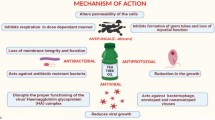Abstract
Data sources
Medline, Cochrane Central Register of Controlled Trials (CENTRAL) and the reference lists of potentially relevant studies and reviews.
Study selection
Randomised controlled or controlled clinical trials conducted in adults (>18yr) comparing 0.12% and 0.2% CHX were included. Plaque scores, parameters of periodontal inflammation and periodontal attachment loss were selected as primary outcome parameters. Only studies written in English were accepted.
Data extraction and synthesis
Study quality (risk of bias) and heterogeneity was assessed. Where appropriate, meta-analysis was conducted using a random effect model. A narrative summary was also presented.
Results
Ten separate experiments were included in the review, and a meta-analysis of seven studies using the same plaque index found a significant difference between 0.2% and 0.12% CHX (p50.008). The Weighted Mean Difference for plaque based on the Quigley & Hein Plaque Index was 0.10 (95%CI [0.03–0.17]) (heterogeneity I2 50%, p=0.87). Three studies that compared 0.12% and 0.2% CHX mouthrinse products provided data on gingival inflammation but no difference between the two concentrations was found. No studies were found that compared the two CHX concentrations and evaluated the probing pocket depth and/or the periodontal attachment level.
Conclusions
In comparing 0.12% and 0.2% CHX, information concerning the effect on gingival inflammation was sparse and no studies could be found that compared the two CHX concentrations and evaluated the probing pocket depth and/or the periodontal attachment level. With respect to plaque inhibition, the results showed a small but significant difference in favour of the 0.2% CHX concentration. However the clinical relevance of this difference is probably negligible.
Similar content being viewed by others
Commentary
We have long known1 that mechanical removal of microbial plaque will reduce gingival inflammation, yet the prevalence of gingivitis in the general population remains high.2 A recent report by Gunsolley3 found that the addition of either chlorhexidine or essential oil mouthrinses resulted in a reduction in plaque scores and gingival inflammation over and above that of oral hygiene instruction and prophylaxis. Thus, chemical plaque control may be a useful adjunct, especially where standard oral hygiene may be compromised.
Chlorhexidine gluconate (CHX) has been in use in Europe for over 40 years, and remains the gold standard by which other mouthrinses are compared. CHX plaque inhibition is dose-dependent, as are the side effects. One of the biggest limitations to the use of CHX, particularly at a strength of 0.2%, is the alteration of taste sensation. Removal of alcohol from the formulation and a reduction to 0.12% are purported to improve patient acceptability.
This paper by Berchier et al. is a rigorous systematic review comparing the difference in plaque inhibition and improvement in gingivitis and periodontitis scores between 0.12% and 0.2% CHX rinse in adults. While only English papers were considered, the search for the best available evidence to answer their clinical question and their analysis of the data were thorough. Only studies comparing 0.12% and 0.2% CHX, with or without alcohol, were included. A combination of criteria from Cochrane, Consort and other authors were used to assess the quality of the studies. All used random allocation, but allocation concealment was unclear in all eight trials. Blinding of the examiner was reported in all studies, but blinding of patients was not used in two. Loss to follow-up was 24% in one study and unclear in two. A priori sample size calculation was not clear in any of the experiments. A power analysis conducted by the authors of the review determined that a sample size of 174 subjects per group would be required to detect a significant treatment effect in any one study (sample sizes ranged from 10 - 80 in total). There was considerable heterogeneity among the trials in terms of volume of mouthrinse used, rinsing time and other active ingredients. None of the trials used periodontal parameters asoutcome measures.
None of the individual trials found a statistically significant difference between 0.12% and 0.2% CHX, but all were under-powered. A meta-analysis for plaque scores using the Quigley & Hein index (extent of tooth covered by plaque on a scale of 0 to 5) favoured 0.2% CHX. The confidence intervals of all but one trial crossed the ‘line of no difference’. Furthermore, the difference in the plaque index of 0.1 begs the question of clinical importance. Subgroup analysis found there was no difference in the use, or not, of alcohol in the mouthrinse or between a 30 or 60 second duration of rinsing.
While the evidence comparing different formulations of chlorhexidine mouthrinse is weak, the results of this systematic review add strength to those of earlier reviews of chlorhexidine as a valuable means of chemical plaque control. For now, it appears that the higher strength and the longer rinsing time may not make as much of a difference as not using an antimicrobial mouthrinse to reduce plaque. The question of the impact of chemical plaque control on periodontal disease remains unanswered.
Practice point
-
Evidence comparing different formulations of chlorhexidine mouthrinse is weak but suggests that higher strength and the longer rinsing time may not be as important as using an antimicrobial mouthrinse.
References
Koch G, Lindhe J . The effect of supervised oral hygiene on the gingiva of children. The effect of toothbrushing. Odontol Revy 1965; 16: 327–335.
Dye BA, Tan S, Smith V, et al. (2007). Trends in oral health status: United States, 1988-1994 and 1999-2004. National Center for Health Statistics. Vital Health Statistics, Series 11: 1–92.
Gunsolley JC . Clinical efficacy of antimicrobial mouthrinses. J Dent 2010; 38 Suppl 1: S6–10.
Author information
Authors and Affiliations
Additional information
Address for correspondence: Dagmar Else Slot, Department of Periodontology, Academic Centre for Dentistry Amsterdam, (ACTA),University of Amsterdam and VU University, Amsterdam, Louwesweg 1,1066 EA Amsterdam The Netherlands. E-mail: d.slot@acta.nl
Berchier CE, Slot DE, Van der Weijden GA. The efficacy of 0.12% chlorhexidine mouthrinse compared with 0.2% on plaque accumulation and periodontal parameters: systematic review. J Clin Periodontol 2010; 37: 829–839. Epub 2010 Jul 7.
Rights and permissions
About this article
Cite this article
Matthews, D. No difference between 0.12% and 0.2% chlorhexidine mouthrinse on reduction of gingivitis. Evid Based Dent 12, 8–9 (2011). https://doi.org/10.1038/sj.ebd.6400771
Published:
Issue Date:
DOI: https://doi.org/10.1038/sj.ebd.6400771
This article is cited by
-
The effect of chlorhexidine on dental calculus formation: an in vitro study
BMC Oral Health (2018)
-
In vitro treatment of Candida albicans biofilms on denture base material with volume dielectric barrier discharge plasma (VDBD) compared with common chemical antiseptics
Clinical Oral Investigations (2015)
-
Human osteoblast damage after antiseptic treatment
International Orthopaedics (2014)



